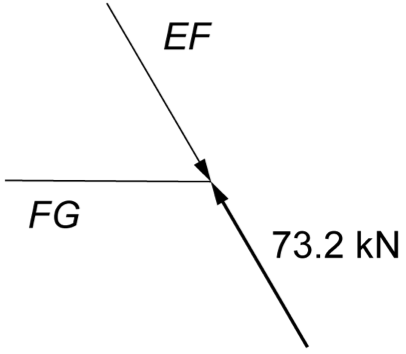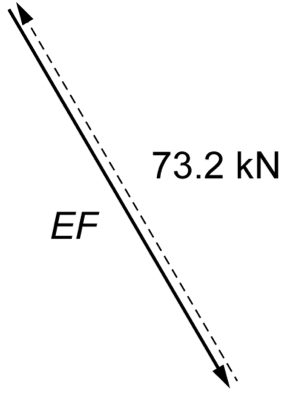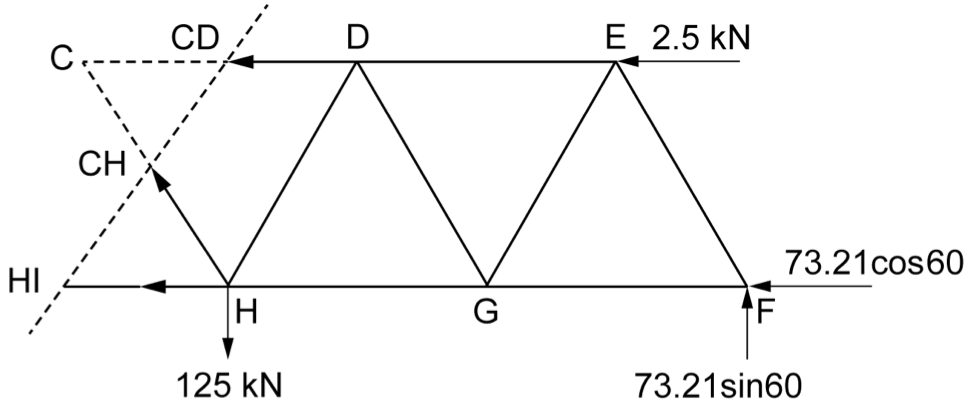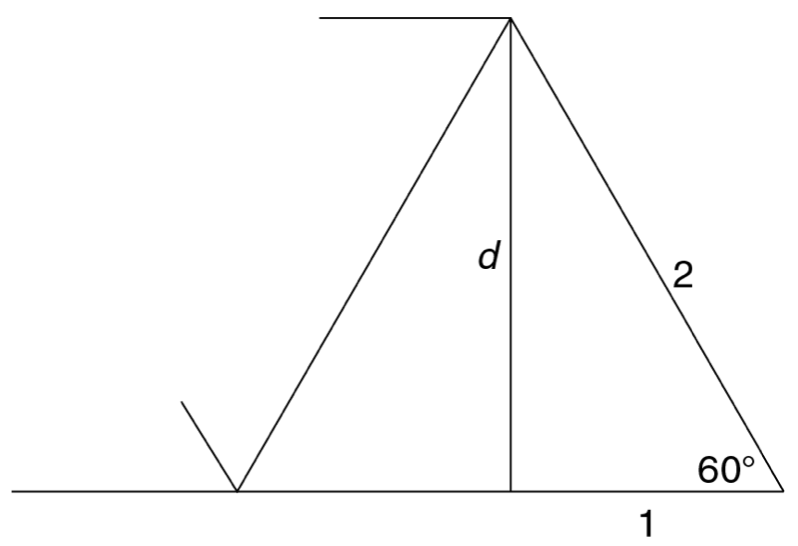A pin-jointed truss is shown. Member \(AB\) has been determined to be 250 N in compression. Complete the table. You must use the method specified to solve each component. (6 marks) --- 0 WORK AREA LINES (style=lined) --- \begin{array} {|l|l|} \begin{array} {|l|l|} \begin{array} {|l|l|}
\hline
\rule{0pt}{2.5ex} \quad \textit{Determine}\quad & \quad \textit{Method to} \quad & \quad \quad \quad \quad \quad \quad \quad \quad\textit{Working} \quad \quad \quad \quad \quad \quad \quad \quad\\
\textit{} \rule[-1ex]{0pt}{0pt} & \quad \quad \ \ \ \textit{use} & \textit{}\\
\hline
\rule{0pt}{2.5ex} \text{External} & \text{Mathematical} & \\
\text{reaction at \(E\)} \rule[-1ex]{0pt}{0pt} & \text{} &\\
\\ \\ \\ \\ \\ \\ \\ \\
\text{} & \text{} & \text{........................... N} \\
\text{} & \text{} & \text{Direction: ...........................} \\
\hline
\end{array}
\hline
\rule{0pt}{2.5ex} \quad \textit{Determine}\quad & \quad \textit{Method to} \quad & \quad \quad \quad \quad \quad \quad \quad \quad\textit{Working} \quad \quad \quad \quad \quad \quad \quad \quad\\
\textit{} \rule[-1ex]{0pt}{0pt} & \quad \quad \ \ \ \textit{use} & \\
\hline
\rule{0pt}{2.5ex} \text{Internal} & \text{Methods of} & \\
\text{reaction of} & \text{section} &\\
\text{member of \(CF\)} & &\\
\\ \\ \\ \\ \\ \\ \\ \\
\text{} & \text{} & \text{........................... N} \\
\text{} & \text{} & \text{Nature of force (T or C): ...........................} \\
\hline
\end{array}
\hline
\rule{0pt}{2.5ex} \quad \textit{Determine}\quad & \quad \textit{Method to} \quad & \quad \quad \quad \quad \quad \quad \quad \quad\textit{Working} \quad \quad \quad \quad \quad \quad \quad \quad\\
\textit{} \rule[-1ex]{0pt}{0pt} & \quad \quad \ \ \ \textit{use} & \\
\hline
\rule{0pt}{2.5ex} \text{Internal} & \text{Graphical} & \\
\text{reaction of} & &\\
\text{member \(BG\)} & &\\
\\ \\ \\ \\ \\ \\ \\ \\
\text{} & \text{} & \text{........................... N} \\
\text{} & \text{} & \text{Nature of force (T or C): ...........................} \\
\hline
\end{array}
ENGINEERING, CS 2023 HSC 19 MC
ENGINEERING, CS 2023 HSC 26c
A truss is loaded as shown.
Showing working, complete the table. (6 marks)
\hline
\rule{0pt}{2.5ex} \rule[-1ex]{0pt}{0pt} & \textit{Magnitude} & \textit{Nature of force}\\ & \text{(kN)} & \text{(T or C)} \\
\hline
\rule{0pt}{2.5ex} \text{Internal reaction of member}\ EF \rule[-1ex]{0pt}{0pt} & & \\
\hline
\rule{0pt}{2.5ex} \text{Internal reaction of member}\ CH \rule[-1ex]{0pt}{0pt} & & \\
\hline
\end{array}
ENGINEERING, CS 2023 HSC 22b
The diagram shows a child with a mass of 45 kg hanging 2 metres from the left end of a structure, and an adult with a mass of 85 kg hanging 1 metre from the right end. \begin{array} {ll}
\text{R}_\text{L} = \text{............................... N} & \text{Direction ...............................} \\
& \\
\text{R}_\text{R} = \text{............................... N} & \text{Direction ...............................} \end{array}
ENGINEERING, CS 2016 HSC 26b
What are redundant truss members? (2 marks)
--- 4 WORK AREA LINES (style=lined) ---
ENGINEERING, CS 2016 HSC 26a
A simplified diagram of a pin jointed truss of a hammerhead crane is shown. It is lifting a load of 54 kN.
- Calculate the reactions at supports `A` and `B`. (4 marks)
--- 8 WORK AREA LINES (style=lined) ---
- Determine the magnitude and nature of the force in member `M`. (2 marks)
--- 4 WORK AREA LINES (style=lined) ---
ENGINEERING, CS 2018 HSC 18 MC
The force `F` is moved from joint `W` to joint `X`, as shown.
Which row of the table correctly describes the changes in the internal force in member `XY` and the reaction force at `W` as a result of force `F` moving from `W` to `X` ?
ENGINEERING, CS 2017 HSC 25a
A pin-jointed truss designed to support a roadside sign is shown.
- Determine the magnitude and direction of the reactions at `A` and `B`. (4 marks)
--- 8 WORK AREA LINES (style=lined) ---
- Determine the magnitude and nature of the force in member `C`. (2 marks)
--- 4 WORK AREA LINES (style=lined) ---
- Explain why concrete would be a suitable material to support the roadside sign around point `D`. (2 marks)
--- 4 WORK AREA LINES (style=lined) ---
ENGINEERING, CS 2019 HSC 22c
The diagram shows some dimensions and forces associated with a telecommunications tower.
By considering any necessary reaction, calculate the magnitude of the forces in members `M` and `N`. State the nature of each force. Ignore the weight of the tower. (6 marks)
--- 12 WORK AREA LINES (style=lined) ---
ENGINEERING, CS 2022 HSC 26a
- The diagram shows a tower crane being used in the construction of a building.
- Determine the number of 100 kg concrete blocks required to place the boom arm in equilibrium. (2 marks)
--- 4 WORK AREA LINES (style=lined) ---
- Under a different set of conditions, a wind force is applied, as shown in the diagram.
- Determine the magnitude and nature of the internal reaction in member A. (6 marks)
--- 12 WORK AREA LINES (style=lined) ---
ENGINEERING, CS 2020 HSC 25c
A cycle bridge has been constructed using a Warren girder truss loaded as shown. The diagram is drawn to scale.
By considering necessary loads and reactions, calculate the magnitude and nature of the force in member `C`. (6 marks)
--- 12 WORK AREA LINES (style=lined) ---
ENGINEERING, CS 2021 HSC 25b
A truss is fixed to a wall at `A` and `B` as shown. Ignore the mass of the truss.
- Determine the horizontal reaction at `A`. (2 marks)
--- 4 WORK AREA LINES (style=lined) ---
- Determine, using method of joints, the internal reaction in member `AC`. Indicate the nature of the force in the member. (3 marks)
--- 6 WORK AREA LINES (style=lined) ---
- Determine, using method of sections, the internal reaction in member `CE`. Indicate the nature of the force. (3 marks)
--- 6 WORK AREA LINES (style=lined) ---
ENGINEERING, CS 2021 HSC 7 MC
The diagram shows a section of a pin jointed truss in equilibrium. The force in Member 1 is 200 kN in compression.
Which row of the table identifies the magnitude and nature of the forces in Member 2 and Member 3?



